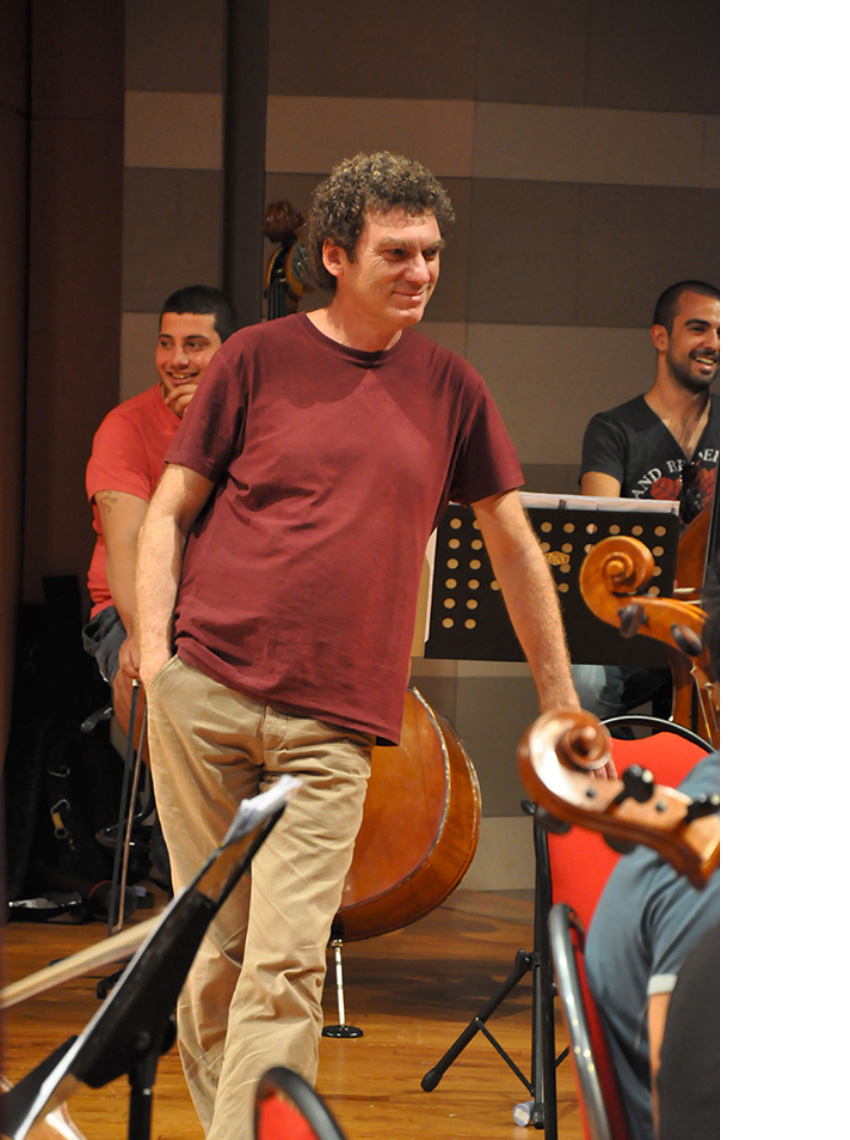The 2018-2019 season has started – and it has done so with a wonderfully encouraging experience. The Turkish National Youth Philharmonic Orchestra (Türkiye Gençlik Filarmoni Orkestrası) kicked off the new season in fine style with a concert at the Zorlu Center in Zincirlikuyu, Istanbul, on September 4 – which happened to be the conductor’s birthday. The cake wheeled onto the stage after the performance had only one candle on it, but it was blown out by Mr Cem Mansur with due panache.
Frankly, I was not expecting much from this orchestra, knowing that in the old days Turkey’s state conservatoires tried to teach young musicians to play instruments without giving them any kind of grounding in general musicianship. Things have obviously changed. During the afternoon before the concert, waiting backstage for a break in the rehearsal so that I could meet the conductor, I experienced serious difficulty in believing my ears. The sounds coming through the thick black curtains blocking my view of the stage were such as could only have been produced by a group of musicians who had received some serious training, and had the ability – and the confidence – to become professionals.

The Turkish National Youth Philharmonic Orchestra is entirely Mr Mansur’s creation. In 2007 he began scouring the state conservatoires (of which there are currently around 12 in various cities around the country) for promising young talents. Since then he has held auditions in the first two months of each year, not only in the major cities but also in Mersin, Edirne and places in between, to identify suitable candidates aged between 16 and 22, and then invited the best of the best to Istanbul in the summer for rehearsals, followed by concerts.
Some of these concerts have been in foreign parts. The orchestra performed at the Konzerthaus in Berlin four times between 2008 and 2017, for instance, and the 2017 concert was broadcast on the Arte TV channel. Other European venues were Rome, Milan, Verona, Ravello, Florence, Bologna, Vienna, Linz, Bonn, Essen, Dortmund, Amsterdam, Budapest, Prague, Bratislava, Brussels, Lisbon, Coimbra, Alicante and Madrid. In 2014 they performed in Tosca in Sicily, and the following year they played in the Royal Opera House production of La Bohème in Istanbul. Not an outfit to be sneezed at, then.
Cem Mansur himself received his initial training at the City University in London. This was followed by an advanced course in conducting at the Guildhall School of Music and Drama. He then crossed the Atlantic to Los Angeles, where he became a pupil of Leonard Bernstein. During his subsequent conductorship of the Istanbul State Opera (between 1981 and 1989), I saw him conduct a very successful performance of Mozart’s Magic Flute – sung in Turkish – at the now defunct Atatürk Cultural Centre in Taksim Square, with the late Ayhan Baran as bass soloist. In more recent years he has been gadding about a fair bit. To choose just one of the many engagements he has had in close to 20 countries, in 2009 he conducted the European première of Arvo Pärt’s Fourth Symphony with the Helsinki Philharmonic Orchestra.
Apart from his efforts to popularise classical music in Turkey, which so far have been conducted without official recognition (and here I must point out that the Turkish State, in its infinite wisdom, does not see fit to finance a national youth orchestra), some of Mr Mansur’s activities have been directed towards the broader goal of social integration. Between 2010 and 2012, for instance, he brought together an orchestra of young musicians from Turkey and Armenia. Another project with a laudable aim has been the Laboratory of Democracy, in which he directs an open rehearsal as a practical illustration of the power of music to bring people together and to teach the value of leadership and cooperation. Here is a link (search ‘Cem Mansur’ within the site).
Now, a link to the Turkish National Philharmonic Youth Orchestra website, which has some content in English, followed by a link to a video on Vimeo of a recent performance in Berlin:
www.genclikfilarmoni.org
And so to the concert itself. Having realised that the orchestra was no amateur affair, I was not surprised that the 83 young musicians present on stage were able to handle Leonard Bernstein’s Divertimento for Orchestra, one of the composer’s later works, without much difficulty. The piece made a good concert opener, being a series of dance movements with lots of gimmicky orchestration and generous smatterings of syncopation. The names of the various movements reveal its origins to be not one thousand miles removed from the United States: Sennets and Tuckets – Waltz – Mazurka – Samba – Turkey Trot – Sphinxes – Blues – March.
The Divertimento is a predominantly light-hearted work written to celebrate the centenary of the Boston Symphony Orchestra (the composer was a native of this city). The various movements are in vividly contrasting styles, though there is an overall melodic basis – the notes B and C, these being the initials of the words ‘Boston Centenary’. The March, Samba and Turkey Trot are in the style of the Boston Pops concerts Bernstein attended in his youth, while the Waltz is in 7/8 time rather than the usual 3/4. (Sennets and Tuckets, by the way, refers to Shakespearian trumpet fanfares.) Here is a YouTube video of the piece played by the Michigan State University Symphony Orchestra:
This was followed by an earlier Bernstein work, the Serenade (after Plato’s Symposium) for solo violin, strings, harp and percussion. The violin part was played by Ms Alena Baeva, who trained at the Moscow Tchaikovsky Conservatoire, an institution celebrated for its supremely high standards and unique ‘straight-up-and-down’ style of bowing. Ms Baeva’s past achievements include winning the Henryk Wieniawski and Moscow Paganini Competitions at the tender age of 16. Among her current chamber music partners are such famous names as Martha Argerich, Yuri Bashmet, Steven Isserlis, Nikolai Lugansky and Mischa Maisky.
With some trepidation (knowing that Leonard Bernstein was Cem Mansur’s mentor in Los Angeles), I have to say that the absence of woodwind and brass must have placed severe restrictions on the composer’s ability to create orchestral colour. I found the work (dare I say it?) tedious. Each of the various movements is named after an ancient Greek philosopher, writer or other famous figure. However, I could not see any particular closeness to these eminent individuals and their work in the music itself. There was, in fact, a good deal of sameness. Furthermore, the lack of a readily perceptible harmonic basis to the chords in any work inevitably creates a feeling of limbo after a time – unless, of course, there are compensating factors such as variety of orchestral colour or rhythmic contrast. In defence of the inclusion of this work in the programme, however, I must add that learning to accompany a soloist is an important part of a youth orchestra’s training, and the young musicians concerned seem well on the way to learning this skill.
All this is not to demean the efforts of the soloist, who gave a professionally competent performance – which is saying a great deal, as she had a huge amount to memorise. In this video, the Serenade is conducted by the composer himself:
After the interval, with the orchestra now properly warmed up, we settled down to enjoy some real Russian orchestral writing in the shape of Prokofiev’s Symphony Number Five in B flat major. If I may project my neck in an outward direction just a little, I will dare to express the opinion that it was the Russians who first grasped the importance of register, and that nobody but them seems capable of producing such haunting, piquant combinations of brass and woodwind. Those screamingly discordant clarinets and thundering tuba solos really are unparalleled anywhere outside Mother Russia – even in Ravel’s flawlessly polished orchestral writing. The Russkis do a nice little number with the snare drum, too.
Prokofiev’s Fifth Symphony was composed in 1944, a momentous year in the history of our planet. Before the performance Cem Mansur gave us some background to the work, emphasising the brutality with which composers in general, and Mr and Mrs Prokofiev in particular, were treated by the Soviet authorities. Coming as it did after Shostakovich’s epic Leningrad Symphony of 1941, this work was generally expected to be a ‘mirror of wartime agonies’. In reality, however, it is far more optimistic in character. Prokofiev himself said: ‘I conceived [the Fifth] as a symphony of the greatness of the human spirit’ – and this is indeed the mood of the triumphant conclusion to the first movement, which follows a dramatic restatement of the opening theme by the brass section. (This was the part that most impressed the audience at the first performance, by the way.) The second movement is a scherzo with some darker undertones, the third slow and lyrical but rather brooding, while the fourth is an energetic Allegro giocoso that ends in an upbeat mood, going out in a blaze of colour after a certain amount of the composer’s characteristic ‘sweet and sour’.
As Mr Mansur explained to us, immediately before the symphony’s première in Moscow on January 13 1945 it was announced that the Russian army had scored a victory on the River Vistula. Guns were apparently fired off in the city in celebration (leading the audience to fear they were being subjected to yet another German air raid). The performance was a triumph for Prokofiev – who, however, fell downstairs in a fit of dizziness shortly afterwards and was badly concussed.
Here is a video of the symphony being played by the Mariinsky Theatre Orchestra conducted by Valery Gergiev:
I have nothing but praise for the Turkish National Youth Philharmonic Orchestra’s performance at the concert on September 4. Their entries were crisp (especially in the Prokofiev), their intonation more than adequate – even in the back desk of the second violins – and the verve and joie de vivre palpably vivacious. Thanks must go, of course, to the Sabancı Foundation as the main sponsors, but chiefly to the redoubtable Mr Mansur, architect of an edifice that he has built up, stone by stone, from its very foundations. Long may it last.










